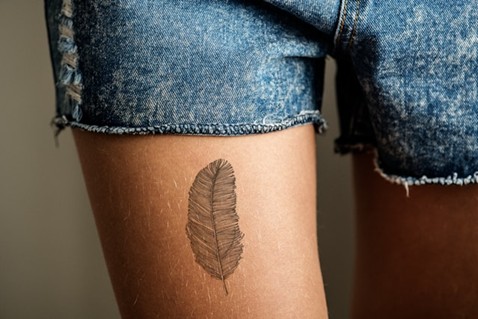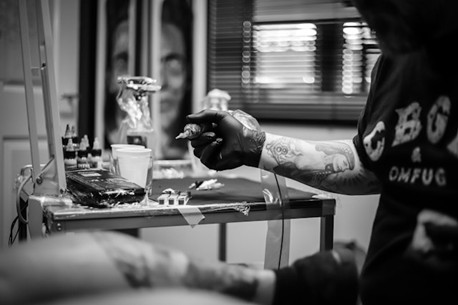
Tattoos have been a form of self-expression, art, and cultural significance for centuries. Over time, tattooing styles have evolved and diversified, giving rise to various techniques, aesthetics, and methods. One such style that has gained tremendous popularity in recent years is fine line tattooing. Known for their intricate designs and the use of delicate, thin lines, these tattoos have quickly become a staple in the body art community, attracting both seasoned tattoo enthusiasts and newcomers alike.
The process typically begins with a detailed design, often transferred onto the skin using tattoo transfer paper to ensure precision and accuracy. This paper serves as a guide for the artist to replicate the design flawlessly on the skin, which is crucial for the detailed work required.
Fine line techniques use extremely thin, delicate lines to create detailed, intricate designs. Unlike traditional tattoos that often feature bold, thick lines and solid black shading, fine line designs are defined by their use of minimalism, precision, and subtleness. The focus is on creating detailed artwork that may be as thin as a hair strand, often resulting in a delicate, almost ethereal look on the skin.
The beauty lies in their ability to deliver incredibly detailed imagery without the need for heavy shading or thick outlines. Instead, artists rely on their expertise with a tattoo machine and needle to create lines that are both precise and light. These tattoos can range from simple line drawings to highly complex pieces that involve shading, dotwork, and geometric designs, all made possible by the artist’s ability to use a delicate hand and exceptional technique.
Creating these designs is not a simple task. It requires both technical skill and a steady hand. The process is painstakingly slow, requiring the artist to work with extreme precision, which is essential when working with such thin lines.
The main challenge is maintaining consistent pressure while using a light touch. This is because the skin’s texture and the slight variation in the human body can make it easy for lines to become uneven. To create smooth, flawless lines, the artist must control the speed of the machine and the angle of the needle while making sure that the lines are consistently thin and clean.
Another challenge is ensuring that the design holds up over time. Fine lines, when not properly executed, can fade or blur, causing the design to lose its definition. The artist needs to take extra care to ensure that the lines are deep enough to stay intact while still maintaining their delicate appearance. Additionally, the healing process is also crucial to achieving the desired outcome, as the tattoo needs to heal without the lines merging or becoming smudged.
The range of designs that can be created using fine line techniques is vast. However, certain motifs and themes have become particularly popular within the tattoo community. Some of the most commonly seen themes in fine line tattoos include:
Floral tattoos have been a staple in the tattoo world for years, but fine line tattoos have taken these designs to a new level. With the delicate nature of fine line work, artists are able to create incredibly detailed and realistic flowers, from roses and peonies to lilies and wildflowers. The precision involved allows for the petals to be finely outlined, giving the flowers a light, airy appearance. This style of tattoo often results in pieces that feel feminine and soft, but they can be equally as bold when done on larger scales or with contrasting elements.
Artists can capture the delicate beauty of animals like birds, lions, or foxes using a combination of minimal lines and shading. These designs are often characterized by their sharp, precise outlines and detailed features, bringing out the essence of the creature without overwhelming the viewer with excess shading or color. These tattoos can evoke a sense of realism or can take on more abstract or stylized interpretations depending on the artist's approach.
Creating realistic portraits with fine lines is a challenging but rewarding aspect of this tattoo style. While traditional portrait tattoos typically require heavy shading and thicker lines to capture the depth and dimension of a person's face, fine line portraits emphasize details in the facial features through delicate lines, creating a softer and more minimalist effect. These tattoos are typically used to represent loved ones, celebrities, or figures of significance, and the skill required to make these portraits look lifelike is an impressive display of fine line technique.
The beauty of minimalist fine line tattoos is their ability to convey meaning and beauty with simplicity. They are often small and subtle, making them ideal for those who want a more discreet or personal tattoo.

Once considered a niche trend, fine line tattoos have exploded in popularity over the past decade. The demand for this type of tattoo has grown significantly, driven in part by social media platforms like Instagram, where tattoo artists can showcase their portfolios and connect with clients globally. The clean, delicate nature of these designs makes them highly photogenic, and as more tattoo artists began to experiment with this technique, their popularity soared.
The style has evolved alongside advancements in tattoo technology. The development of more precise tattoo machines and needles has allowed artists to create finer, cleaner lines than ever before. This, combined with an increase in demand for more personal, intricate designs, has led to the fine line style becoming a mainstream phenomenon within the tattoo community.
Many people now seek tattoos that are unique and tailored specifically to them, rather than opting for traditional flashy designs. Fine line tattoos offer a level of customization that makes them ideal for those looking for something truly personal. With their intricate, detailed nature, fine line tattoos are often seen as high-art tattoos, where the design is as much about aesthetics as it is about symbolism.
As tattoo technology improves and artists refine their techniques, the level of precision achievable with fine line tattoos will only get better. With more people turning to body art for self-expression, the intricate, delicate style of fine line tattoos is likely to remain in demand as it allows individuals to make subtle yet powerful statements through their ink.
As the cultural perception of tattoos continues to shift, with tattoos being more widely accepted in mainstream society, the demand for custom, artistic, and unique tattoos is expected to grow.
Fine line tattoos represent a fusion of skill, creativity, and precision. With their intricate, detailed designs and use of thin, delicate lines, they offer a modern twist on traditional tattoo art. Whether it’s a minimalist symbol, an animal, or a lifelike portrait, fine line tattoos provide the opportunity for individuals to showcase their personal stories, beliefs, and tastes in a beautiful and subtle way. As the tattoo community continues to evolve, fine line tattoos are sure to remain a popular choice for those looking to add an elegant, meaningful touch to their skin.